VMS IDE how to
Installing Visual Studio Code
To start working with VMS IDE you need to install Visual Studio Code editor.
- Go to https://code.visualstudio.com/
- Click the download dropdown button and select the build for your platform (Windows, Mac, or Linux). The installer will be downloaded.
- Run the installer and follow the instructions
(!) This guide uses Visual Studio Code for Windows
Installing VMS IDE extension
- Select Extensions view in the Activity Bar
- Type “vms ide” into the search box
- Select VMS IDE extension
- Click the Install button in the Extensions view
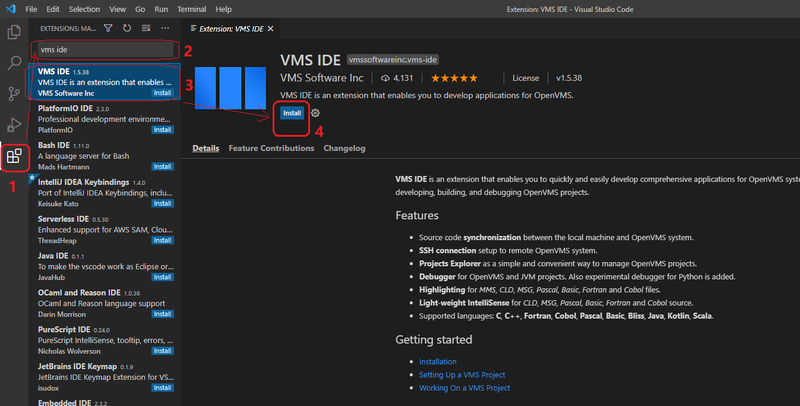
VS Code will install the extension. To verify that it is installed:
- Go to File → Preferences → Settings
- Type “vms ide” to the Search bar in the Settings tab
The extension will be displayed in the list of settings:
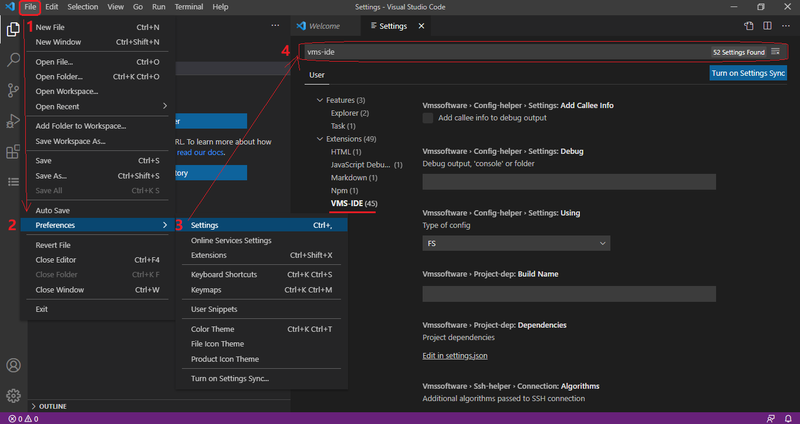
Creating and setting up a project
Creating a project folder
To start working on your project you need to open the folder that will be used as a project folder.
- Select the Explorer view in the Activity bar
- Click the Open Folder button
- Select a folder for the project in the dialog window and click the Select Folder button.
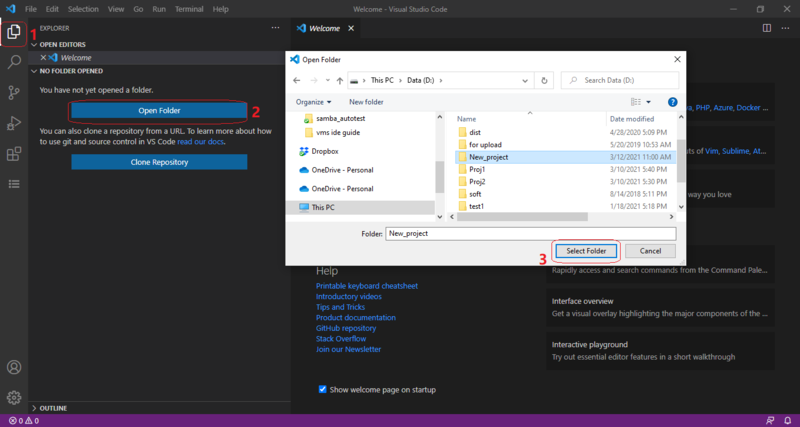
The selected folder is shown in the Explorer tab. All project files and directories will be shown in this panel.
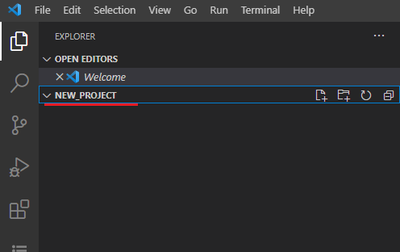
The alternative way to open the folder: File → Open folder… → Select a folder for the project
Updating workspace settings
From the official page of VS Code:
A Visual Studio Code "workspace" is the collection of one or more folders that are opened in a VS Code window (instance). In most cases, you will have a single folder opened as the workspace but, depending on your development workflow, you can include more than one folder, using an advanced configuration called Multi-root workspaces.
Before you start working on your project you need to set up your workspace. Two important options that you need to set are
- End of Line character
- Type of configuration
End of Line Character
To select the end of line character:
- Click the Manage icon in the Activity bar
- Click Settings in the popup menu
- Select Workspace in the Settings tab
- Type “eol” in the search bar
- Select “\n” (LF) in the Files: EOL drop-down list
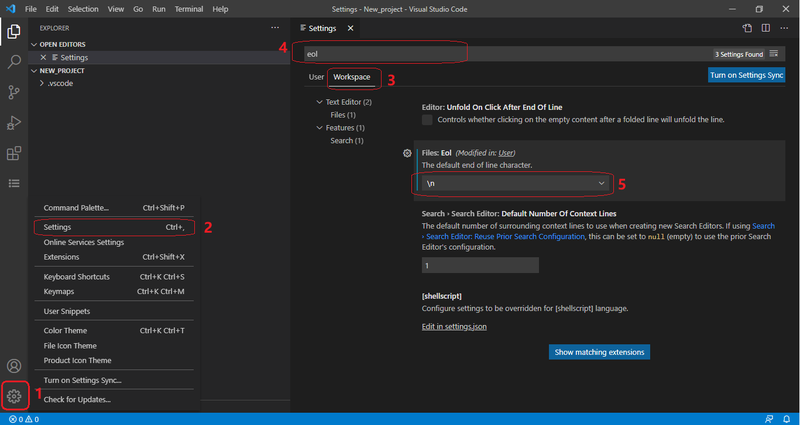
After changing EOL the .vscode directory with settings.json will be created in your project folder.
Type of configuration
To select the type of configuration:
- Select Extensions view in the Activity bar
- Right-click the Gear icon of the VMS IDE extension
- Click the Extension Settings
- Select the Using Type item of the config from the drop-down list. We recommend using FS (default value)
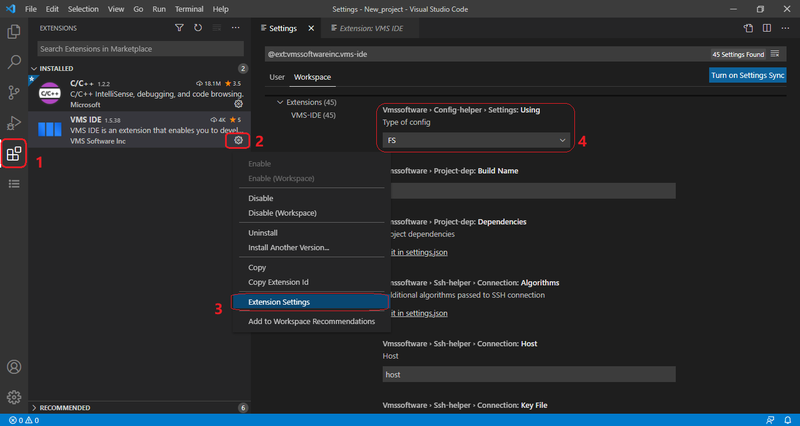
All project, ssh, and other settings will be saved in JSON files in the .vscode directory of the project folder.
Updating project settings
Create a project configuration file
You need to create a file with project configuration and specify your project settings in it:
- Click the View menu option
- Select Command Palette… option from the View menu
- Type “>VMS-IDE: edit VMS project settings” in the Command Palette bar
- Select the “VMS-IDE: edit VMS project settings” command from the drop-down list

The editor opens vmssoftware.synchronizer-settings.json
- Specify your project settings (see info about parameters and values below).
- Save file: press <Ctrl>+<S> or select File → Save
The vmssoftware.synchronizer-settings.json file will be saved in the .vscode directory in the root of the project folder.
Customize project configuration
After the file is created you need to customize it specifying the parameters. The structure of the vmssoftware.synchronizer-settings.json file consists of 3 sections:
- Project - general project settings
- Synchronize - synchronizer specific settings
- Builds- build configurations for the project
(!) Follow the links to view all the options for each section.
Generally, in the project section you need to:
- Set the
rootdirectory. For example, if the project is located in WORK:[USER.DEMOS.SIMPLE] and the home directory is WORK:[USER], set the parameter value to demos/simple or /work/user/demos/simple - Select the
projectTypethat you need - Specify the
projectName. WARN: Do not use spaces or special characters in theprojectName - Check
builders. These files will be synchronized. - Check
headers. These files will be synchronized and included in the auto-generated MMS file as header files. Changing any of them will result in a full project rebuild. - Check
source. These files will be synchronized and included in the auto-generated MMS file as source files. - Check
resource. These files will be synchronized but not included in the auto-generated MMS file. - Adjust the
excludefield value to list the files similar to the described above but not to be synchronized and compiled. - Check
listing. These files will be downloaded after building the project. Files "*.lis,*.map" are required for the debugger. - If the project depends on already installed libraries, specify them in the
addLibrariesandaddIncludes
Glob syntax:
* to match one or more characters in a path segment
? to match one character in a path segment
- to match any number of path segments, including none
{} to group conditions (for example {**/*.html,**/*.txt} matches all HTML and text files)
[] to declare a range of characters to match (example.[0-9] to match on example.0, example.1, …)